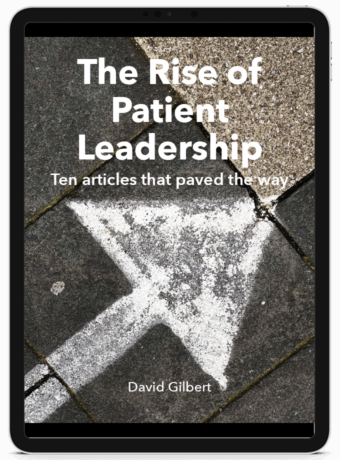Trying to Model Patient Leadership Behaviour – a 2021 resolution
In the murky year that has been, what has made you proud?
About a year ago, I was courted by an organisation intrigued by Patient Leadership. During several conversations, they became committed to securing the services of a Patient Director, alongside a more embedded model of Patient Leadership.
I suggested an approach that would build on their commercial niche – providing nurse-led health coaching for people with long term conditions. This would entail, I proposed, ways of developing an online network of their patients, linking them to each other through informal peer support and training up some to become ‘professional’ health coaches.
The model would then build a further progression route by which some of those health coaches would work with the nurses as part of service delivery, and then enter more strategic roles in improvement and governance.
This is the embedded model that could pave a way for patient leadership across health services – I was confident that this organisation was serious in its intent and would act ethically in order to develop the model.
I am a sharer, perhaps naïve at times. But the alternative to sharing is to become passive, cynical and roll up in a ball and eventually die lonely. Something I would prefer not to do. So, I continue to expose myself. I will not apologise for that.
This organisation decided, without pre-informing me, that they would put the ‘Patient Director’ role – a two-day a month post – out to open competition. They did not have to, being an independent sector organisation. The job description and person specification was entirely built on the suggestions I had offered. I went for the job without complaint – acknowledging their right to proper transparency. They then said that they had re-thought the role, that they would not appoint, and that the role would be developed by someone in-house.
In effect, from my perspective, they had stolen my ideas for their own competitive advantage and left me bereft. Perfectly within their rights of course. But the spirit in which they had undertaken each step now rankled – I looked back at how they had lured me at each step of the way to part with more and more of my wisdom and insight, gleaned from thirty years of struggle.
I am not here going into the ins and outs of whether or not they behaved ethically or not. My belief is that they had not. But this blog is more about the emotional resonance of the process – something that many ‘patient leaders’ out there might recognise.
My aim here is to disentangle the personal reaction from the professional. Something that is not second nature to those of us who wear our heart on our sleeve; we can perhaps too easily default into a trauma-induced resurrection of more ‘natural’ tendencies – even replaying the role of ‘victim’ and thus further reinforcing our marginality and sense of otherness.
I hope that by doing this, I can offer something helpful to those who have suffered from an echoing heartlessness on the part of those in the system.
Triggered by this situation reminding me of previous situations in my life – of my brain being sucked for free and then being spat out – I wrote a lengthy and emotional missive that outlined the hurt and immorality of their approach. My finger hovered over the ‘send’ button.
For once, I paused…
I desisted. I took myself off for a long day’s walk on the Brighton beach. I wrote poetry, phoned a couple of friends, drank copious amounts of cappuccino and ate far too many pastries. I re-established some priorities for 2021 – that I would finish my current manuscript of poetry, begin writing another book, and commit my patient leadership knowledge to a series of training videos to be produced in the new year.
Then, after a week or so, I went back to the email. I took out all the references to my being hurt, avoiding any sense of self-pity. Which I often find hard. There is no doubt, that whatever one’s ‘case’, by bleating about the unfairness, I risked pigeon-holing myself in an ancient narrative of the upset (and perhaps spoilt) ‘child’. There was no doubt in my mind that I was ‘right’, but I was held back from sending the note by a sense of how my actions would be perceived. This also lent credence to my decision not, this time, to vent on social media – I do not want any more to to risk being labelled as ‘adolescent’. ‘Oh there goes Gilbert again’ was the image that I conjured up.
And this time I wanted to behave like a grown up – modelling equality of power and responsibility – and point out at a professional level what had happened. That this behaviour of theirs was unworthy, unprincipled, unprofessional and certainly did not, ironically, model any patient leadership principles that I knew of. Certainly, if they had treated a health professional in this way – if the role for example had been for a ‘Clinical Director’, then I do not think they would have dared to behave in the same manner. I wanted to point some of this out without so much emotional angst.
So the note went out. I pointed out the facts of the case, listed what I had provided to them in good faith and free of charge. Told them how their process and decision-making was the antithesis of the model of leadership they espoused. And, crucially, attached an invoice for my services. This symbolises for me the value I put upon myself.
I am now waiting for a response and will chase them when the standard 28 days of waiting is up. And I will continue to re-send the invoice.
I then wrote another email to a friend: ‘I am feeling proud of myself. I did not lapse into the child. I paused, took stock, used my energy to refuel my primary purposes for next year, got some poetry out of it, took more careful aim, then behaved like someone who truly deserved to be respected – and properly valued for what I had done. I feel bloody good about myself’.
And I still do. Whether or not they pay is beside the point. I have put a mark in the sand. And at the end of such a murky year, I am clear about where I stand.
I will try and do more of that in 2021.
What are you proud of? What will you try do more of in 2021?
Thanks for reading.


Happy New Year David. As always I am inspired and bowled over by your bravery. Please carry on being you! I am wishing you all the very best with your projects this year.
All very best wishes
Elouise x